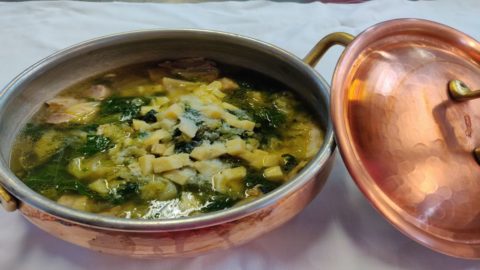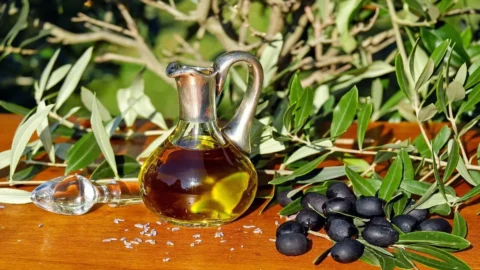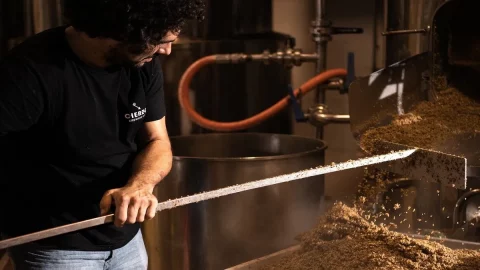For the Neapolitans it is the obligatory dish of the Christmas holidays but also of the Easter ones. For others it is an abstruse name that also inspires a little awe. It is 'a Menesta 'mmaretata, (married soup) so nicknamed because it celebrates an ancient culinary marriage between meat and vegetables, or rather between an infinity of meats and an infinity of vegetables, canonized over the centuries.
To tell the truth, even if it is an iconic dish of the Neapolitan gastronomy tradition, the menesta mmaretata has Spanish origins. It reinterprets the Olla Podrida, another not very reassuring name, introduced in the Kingdom of Naples by the Aragonese domination. Olla Podrida literally stands for rotten pot, but in this specific case the name derives from the term "poderida", which means powerful. The reason is obvious: it is a stew originally from Spanish cuisine already present in the gastronomy of the Middle Ages, and classified within the family of boiled meats. A mixture composed of heterogeneous ingredients, legumes, pieces of meat, various spices, typical of Spanish cuisine.
But Poderosa also because it is rich in ingredients that gave it a lot of strength and for this reason the Olla was reserved only for the nobles during the holidays - a tradition later imported into Naples too - while the common people could not go beyond a simple soup with poor vegetables from the field.
The maritata soup we eat today is a distant memory of the rich and, in truth, heavy Spanish minestrone whose Neapolitan variant was defined not by chance by the gastronome Ippolito Cavalcanti Duke of Buonvicino "or fat pignato".
It remains a complex dish due to the various canonical ingredients imposed by tradition. Six mandatory vegetables: turnip broccoli, broccoli leaves, cicorielle (small chicory), torzelle (also known as "Greek cabbage" or "curly torza", a plant found above all in the Acerrano Nolano area, in the province of Naples) , cappucce and scarolelle to which someone also adds borage And three different types of meat: beef, chicken and pork. But as far as the latter is concerned, tradition has it that seven variations are used: uoss' 'e ham, pork rinds, mascariello (cheek) vuccularo (a part of the muzzle), lard, nnoglie (beggar salami), tracchie (ribs) and verrinia.
A marriage therefore very demanding for the officiant, the cook or the housewife, who must unravel all these ingredients to sublimate them in a soup with a thousand aromas and flavors and above all easy to digest.
To propose a light version of the old "fat pignato" we opted for the recipe of one of the historic restaurants of the Neapolitan gastronomic tradition, Mimì alla Ferrovia. A restaurant born in September 1944, by Emilio Giugliano called Mimì and his wife Ida, a year after the glorious Four Days of Naples, the popular insurrection that earned the city, first among the big European cities to rise up against the Nazi troops, the awarding of the gold medal for civil valor.
That good-natured trattoria born as an act of faith in the country's return to normality, still in the middle of the war, (and this should make many who complain about the conditions of the present think about it) has over time become one of the classic icons of Neapolitan catering. The proximity to the Odeon theater, the station, the seaport, the entrance to the junction for the motorways. to the Court meant that this place soon became a point of reference for the Neapolitans and for those arriving in Naples for work or tourism who knew they would find a welcome from Mimì alla Ferrovia and an environment full of all the warmth that the Neapolitans know how to express but also the genuineness of a cuisine that was establishing itself in the world according to the principles of the Mediterranean diet. “Italy passes through Mimì” Michele Giugliano loved to repeat with a broad smile of satisfaction for the notoriety quickly achieved by his restaurant in Via Alfonso D'Aragona. It was not a boast but a factual observation as attested by the hundreds of photos that occupy all the walls of the restaurant and which wind like a long history of Italy that counts through the years.
Leading the kitchen today is the latest generation of the Giugliano dynasty, Salvatore, a smiling boy, who expresses himself with shy and pleasant grace which however loses in front of the stove where the Chef moves with the confidence and mastery acquired in rapid intense years of study and passion. He has walked all the steps of the family business. He was practically born in the restaurant, then he decided to gain experience going around by sifting some of the great masters of Neapolitan starred cuisine where he was able to gain important experiences for his training. Starting with Paolo Barrale, the chef who for 14 years led the "Marennà" restaurant at the Feudi di San Gregorio, to continue at the court of Tonino Mellino, patron of the multi-starred Quattro Passi in the bay of Nerano in the Sorrento peninsula, The subsequent experience at Faro di Capo d'Orso with chef Franco Ferrara made him broaden his gaze to French-inspired techniques. From here he moves to Ischia,
There is Nino Di Costanzo, two Michelin stars, a spiritual father of traditional Neapolitan cuisine, capable of bringing popular Neapolitan cuisine to the level of poetry, recently considered by Forbes as one of the 10 coolest restaurants in the world. With so much schooling, the young Salvatore would be ready to return to the family flagship. But he doesn't do it. There is still to raise the level of knowledge to new cooking techniques and treatment of matter. And for this reason the Chef goes to Japan for a "human and professional journey" as he says but above all to deepen the approach with a cuisine that aims at the essential, at the intimacy of the meaning of the raw material, at a rarefaction of the most immediate aspect of taste because this is perceived by all the senses. And now here he is at Don Mimì's stove from where he gives us the recipe for Menesta mmaretata, to take a leap into the history and ancient flavors of a people.
Chef Salvatore Giugliano's soup recipe
Ingredients:
6 small smooth endives
6 beets
6 borage
3 tortellini
1 savoy cabbage
diced pecorino romano
1 ham bone
600 g priest's hat
600 gr hen
300 g sausages
3 celery
2 carrots
Thoroughly clean the innards from the hen and cut it in half. Cut the priest's hat into cubes. the same for celery and carrots.
Add everything to a saucepan with cold water, a bunch of aromatic herbs, the ham bone and the sausages. let the broth cook for about 4 hours, degreasing it with a slotted spoon during cooking.
Blanch the vegetables in boiling water and cool them in water and ice to keep them shiny and crunchy.
When the broth is ready, raise the meat and filter through a fine-mesh chinoix covered with a cloth.
cut the sausages into slices, debone the hen and place everything in a pot together with the vegetables and beef.
Bring to temperature and serve in a deep dish with the Roman pecorino cubes.
The menesta mmaretata in Naples also occurs for the Easter holidays.
Salvatore Giugliano of the Mimì alla Ferrovia restaurant offers a second version with seasonal vegetables. Here she is:
A ham bone
250g of pork rinds
250g of cotechino or salami
300g of pork pulp
3 sausages
150g of lard
sale
500g of broccoli
400g of broccoli
1kg between escarole and chicory
500g of cappuccino salad





